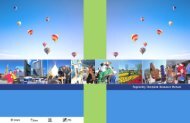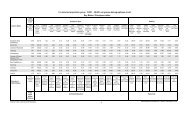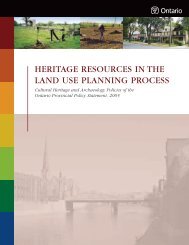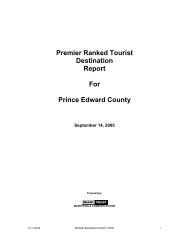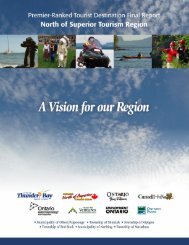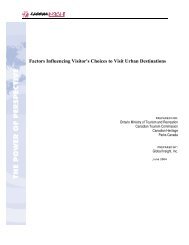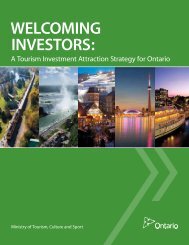Management Guidelines For Forestry and Resource-Based Tourism
Management Guidelines For Forestry and Resource-Based Tourism
Management Guidelines For Forestry and Resource-Based Tourism
- No tags were found...
Create successful ePaper yourself
Turn your PDF publications into a flip-book with our unique Google optimized e-Paper software.
<strong>Management</strong> <strong>Guidelines</strong> for <strong>For</strong>estry <strong>and</strong> <strong>Resource</strong>-<strong>Based</strong> <strong>Tourism</strong> – EXECUTIVE SUMMARYExecutive Summary<strong>Management</strong> <strong>Guidelines</strong> for <strong>For</strong>estry <strong>and</strong> <strong>Resource</strong>-based <strong>Tourism</strong> are to be used in the development of forest managementplans for those portions of the forest used for forestry <strong>and</strong> resource-based tourism. The <strong>Guidelines</strong> may also beuseful during the development of <strong>Resource</strong> Stewardship Agreements. Those features of the forest used by the touristindustry are described in the <strong>Guidelines</strong> in general terms. Measures which may be taken to assist with specific identificationof resource-based tourism values are outlined. The resource-based tourism industry itself is divided into threetypes: drive in, semi-remote <strong>and</strong> remote. One of the most challenging aspects of managing the interface betweenremote tourism <strong>and</strong> forestry is the planning of roads <strong>and</strong> their use. The forest industry requires roads to harvest, renew<strong>and</strong>, maintain the forest, while segments of the tourist industry need some areas which are "functionally roadless." Theneed to provide the resource-based tourism industry with a "reasonably similar level of remoteness" is recognised in the<strong>Tourism</strong> <strong>and</strong> <strong>For</strong>estry Industry Memor<strong>and</strong>um of Underst<strong>and</strong>ing approved by the Ontario government in 2001. Allresource based tourism business depends in part on a visually forested l<strong>and</strong>scape <strong>and</strong> a forest that is free from unwantedor disturbing noise. <strong>For</strong>est management planners must consider the needs of the tourist industry when developingplans; however, they must also consider a wide range of environmental needs. Both tourism <strong>and</strong> environmental needsvary by forest type <strong>and</strong> site. A further challenge for forest management planners is the need to consider the interests ofother stakeholders such as anglers <strong>and</strong> hunters. The decision to apply a specific technique to protect a tourism value isnot a simple decision.When the desired degree of remoteness in the forest is determined <strong>and</strong> other needs of the resource-based tourismindustry established, the task of selecting a specific forestry tool or technique to address the needs of the resource-basedtourism industry follows. <strong>Management</strong> <strong>Guidelines</strong> for <strong>For</strong>estry <strong>and</strong> <strong>Resource</strong>-based <strong>Tourism</strong> describes a range ofpractices, tools <strong>and</strong>, techniques that should be considered when developing forest management prescriptions to protectresource-based tourism values. The information provided is based on operational experience. New <strong>and</strong> creative techniques,which may evolve over time, are encouraged as long as they do not contravene existing legislation. In practice, acombination of techniques usually produces the intended result (e.g. sign erected <strong>and</strong> culvert removed.) The informationis organised under the headings: Access <strong>Management</strong>, Visual Aesthetics/Views, Noise Control <strong>and</strong>, Planning.These <strong>Guidelines</strong> are intended for use by both forest management planners <strong>and</strong> owners/operators of resource-basedtourism businesses. To ensure that readers are able to make best use of these <strong>Guidelines</strong> extra effort has been taken toexplain how these <strong>Guidelines</strong> may be used in conjunction with the forest management plan development process. Anumber of "Tips" are contained in the <strong>Guidelines</strong>. "Tips" are not presented as "direction;" rather, the team which preparedthe <strong>Guidelines</strong> felt there was merit to provide information to the user which might be used in any number ofways to assist with managing the forestry/tourism interface.To ensure the continued effectiveness of forest management plans forest management guidelines should be evaluated.<strong>Resource</strong>-based tourism values <strong>and</strong> the methods used to protect these values are most often determined through discussions<strong>and</strong> negotiations between the resource-based tourism industry <strong>and</strong> forest management planner. <strong>Tourism</strong> valuesare quite different than other values that are the subject of forest management planning guidelines. Those features ofthe forest important to the tourist industry are not readily inventoried <strong>and</strong> are not supported by strong science. In factmany of the values used by the tourist industry are business specific; that is to say what may be important to onetourism business may be of relatively little importance to another. The means, then, of determining the effectiveness ofthese <strong>Guidelines</strong> must consider the effectiveness <strong>and</strong> efficiency of negotiations with the underst<strong>and</strong>ing that neitherparty to these negotiations may be entirely happy with the negotiated outcome but at the least they have what theyrequire to pursue their business interest.IV



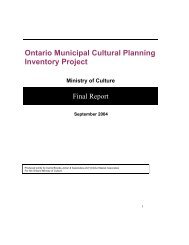
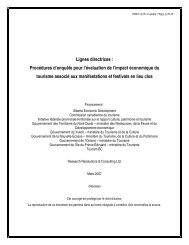
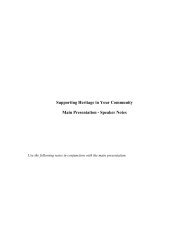
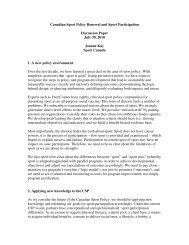
![THIS AGREEMENT made this [date], between [name of owner] (the ...](https://img.yumpu.com/49827605/1/158x260/this-agreement-made-this-date-between-name-of-owner-the-.jpg?quality=85)
